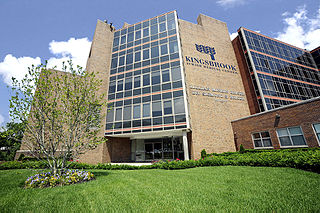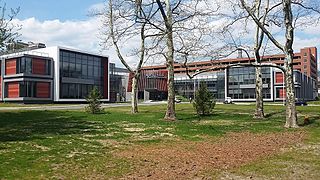Related Research Articles

Hollis is a residential middle-class neighborhood within the southeastern section of the New York City borough of Queens. While a predominantly African-American community, there are small minorities of Hispanics and South Asians residing in the area. Boundaries are considered to be 181st Street to the west, Hillside Avenue to the north, Francis Lewis Boulevard to the east, and Murdock Avenue to the south. Hollis is located between Jamaica to the west and Queens Village to the east.

A sanatorium is a medical facility for long-term illness, most typically associated with the treatment of tuberculosis (TB) in the late-nineteenth and early-twentieth century before the discovery of antibiotics. A distinction is sometimes made between "sanitarium" or the east-European "sanatorium" and "sanatorium".

Jamaica High School was a four-year public high school in Jamaica, Queens, New York. It was operated by the New York City Department of Education.

The Martin Luther King Jr. Outpatient Center, formerly known as Martin Luther King Jr. Multi-Service Ambulatory Care Center, Martin Luther King Jr./Drew Medical Center (King/Drew), and later Martin Luther King Jr.–Harbor Hospital, was a public urgent care center and outpatient clinic and former hospital in Willowbrook, an unincorporated section of Los Angeles County, California, north of the city of Compton and south of the Watts neighborhood of Los Angeles.
Dignity Health St. Joseph's Hospital and Medical Center is a hospital in Phoenix, Arizona, United States, operated by Dignity Health. St. Joseph's is a 607-bed, not-for-profit hospital that provides a wide range of health, social and support services, with special advocacy for the poor and underserved. It is home to the Barrow Neurological Institute, the world's largest dedicated neurosurgical center and a renowned leader in neurosurgical training, research, and patient care.
The "Dr. X" killings were a series of suspicious deaths by curare poisoning, in 1966 at a Bergen County, New Jersey hospital. A newspaper investigation during the mid-1960s led to the indictment of an Argentina-born physician, Mario Enrique Jascalevich, in 1976. He was acquitted at trial in 1978.

Walla Walla General Hospital was a 72-bed acute-care hospital located at the base of the Blue Mountains and served approximately 70,000 residents of Southeastern Washington and Northeastern Oregon. It closed in July 2017.

Queens Hospital Center (QHC), also known as NYC Health + Hospitals/Queens and originally called Queens General Hospital, is a large public hospital campus in the Jamaica Hills and Hillcrest neighborhoods of Queens in New York City. It is operated by NYC Health + Hospitals, a public benefit corporation of the city.
The Laurel Sanitarium for Nervous and Mental Diseases was a prominent sanitarium, and later a women's nursing home, and landmark building along U.S. Route 1 in Laurel, Maryland. The sanitarium was founded in 1905 by Dr. Jesse C. Coggins and Dr. Cornelius DeWeese to treat patients with mental illness and addiction. It was converted to a women's nursing home in 1950. The facility closed after Coggins' death in 1963, and was demolished by controlled fire in 1964.

Kingsbrook Jewish Medical Center is a 303-bed full-service community teaching hospital with an estimated 2,100 full-time employees, located in the neighborhood of East Flatbush in Brooklyn, New York. The hospital is made up of a complex of eight conjoined buildings which are dispersed over a 366,000 square foot city block.

Zucker Hillside Hospital is a psychiatric facility that opened in 1926, relocated to its present address in 1941, and was renamed in 1999 to its present name.
Alfred A. Richman was "an orthopedic surgeon and an honorary trustee of Beth Israel Hospital" who "founded Manhattan General Hospital in 1928 and was its executive director."
Astoria Sanitarium, also referred to as Daly's Astoria Sanitarium, was a private hospital owned by Dr. John F. Daly.
Hillcrest General Hospital was opened around 1962 by a physician who "was chief of medicine there for 25 years." Hillcrest, a private hospital, was then sold to an investor, who leased it to Osteopathic Hospital and Clinic. Osteopathic previously had acquired another hospital to which they subsequently relocated, and the 5-story building became St. Joseph's Hospital in 1985.
References
- 1 2 "HILLSIDE HOSPITAL MUST CLOSE AUG. 15; Greef's Aide Tells Dr. Gitlin Permit for Sanitarium in Jamaica Is Revoked". The New York Times . July 31, 1931.
- 1 2 "DENY JAMAICA NEED FOR GITLIN HOSPITAL; Bennett Aides, in Brief Fighting Charter, Charge Laxity in Hillside Sanitarium. DEATHS IN ONE YEAR CITED 44 Patients Said to Have Succumbed Within 72 Hours of Admission-- State Group Acts Tuesday. Says Hospital Is Needed. Advisory Board Disbanded". The New York Times . July 26, 1931.
- ↑ "50 Doctors attend Opening Dinner at Hillside Sanitarium". Long Island Daily Press. January 5, 1926. p. 3.
- 1 2 "City's Order Closes Hillside Sanitarium - Fay Refuses Further Permits to Queens Private Hospital, Turned Down by Welfare Board". The New York Times . August 16, 1931. p. 23. Retrieved October 20, 2015.
- ↑ "INQUIRY IN HILLSIDE DEATH.; Medical Examiner Says Autopsy Shows No Evidence of Negligence". The New York Times . August 30, 1931.